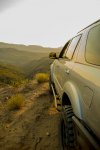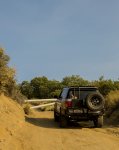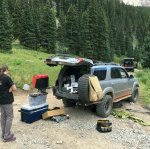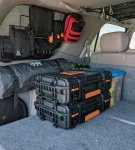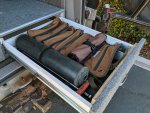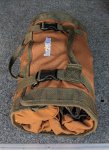Sal R.
Active member
MODIFICATION: WaterPORT
GOAL:
Move the WaterPORT from the roof rack.
PURPOSE:
The WaterPORT is great to have. Not only for trips, but it's great washing off the beach days, and cooling off after hikes and runs, as well. But it's not very convinient being on the roof and having to break it down when I'm not using it. I never liked keeping it up there all the time because it added unnecessary height. I wanted a permanent solution that wasn't so obtrusive.
DURATION: 1 hour
MATERIALS:
WaterPORT
Large QuickFist clamps x2
Misc nuts and bolts
COST: $110
HOW-TO:
I used to carry my waterport on the roof rack and it was held in place using the large QuickFist clamps.
Since I don't carry a spare anymore under the car, it looked like a great spot to mount the WaterPORT. Rather than reinvent the wheel, I opted to keep using the QF clamps. I kept the install simple, accessible, removable, and portable.
I used the existing crossmember that held the spare to mount the clamps to. I removed the lifting mechanism (held in place using 4 12mm bolts), drill 6 holes, mount the QF clamps, mount the WaterPORT. Thankfully, it doesn't hang too low nor does it impact my departure angle...I think.
It's an ideal spot for 30lbs of gear to keep the vehicle CG low.
And I'm all about keep it low.


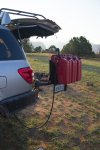
The fill/output port is easily accessible under the car. The shrader valve has plenty clearance from the muffler. If needed, I can just undo the clamps and remove the WaterPORT.
I do need to find a capping solution for the fill/output port to help keep debris and the elements out of it.
GOAL:
Move the WaterPORT from the roof rack.
PURPOSE:
The WaterPORT is great to have. Not only for trips, but it's great washing off the beach days, and cooling off after hikes and runs, as well. But it's not very convinient being on the roof and having to break it down when I'm not using it. I never liked keeping it up there all the time because it added unnecessary height. I wanted a permanent solution that wasn't so obtrusive.
DURATION: 1 hour
MATERIALS:
WaterPORT
Large QuickFist clamps x2
Misc nuts and bolts
COST: $110
HOW-TO:
I used to carry my waterport on the roof rack and it was held in place using the large QuickFist clamps.
Since I don't carry a spare anymore under the car, it looked like a great spot to mount the WaterPORT. Rather than reinvent the wheel, I opted to keep using the QF clamps. I kept the install simple, accessible, removable, and portable.
I used the existing crossmember that held the spare to mount the clamps to. I removed the lifting mechanism (held in place using 4 12mm bolts), drill 6 holes, mount the QF clamps, mount the WaterPORT. Thankfully, it doesn't hang too low nor does it impact my departure angle...I think.
It's an ideal spot for 30lbs of gear to keep the vehicle CG low.
And I'm all about keep it low.



The fill/output port is easily accessible under the car. The shrader valve has plenty clearance from the muffler. If needed, I can just undo the clamps and remove the WaterPORT.
I do need to find a capping solution for the fill/output port to help keep debris and the elements out of it.
Last edited:

